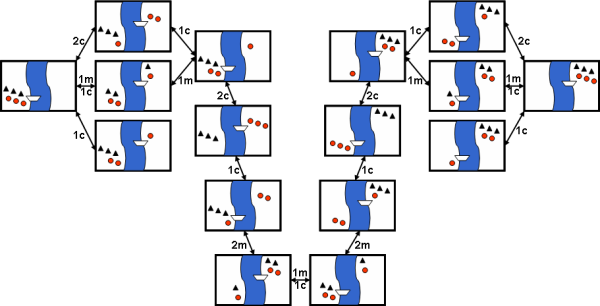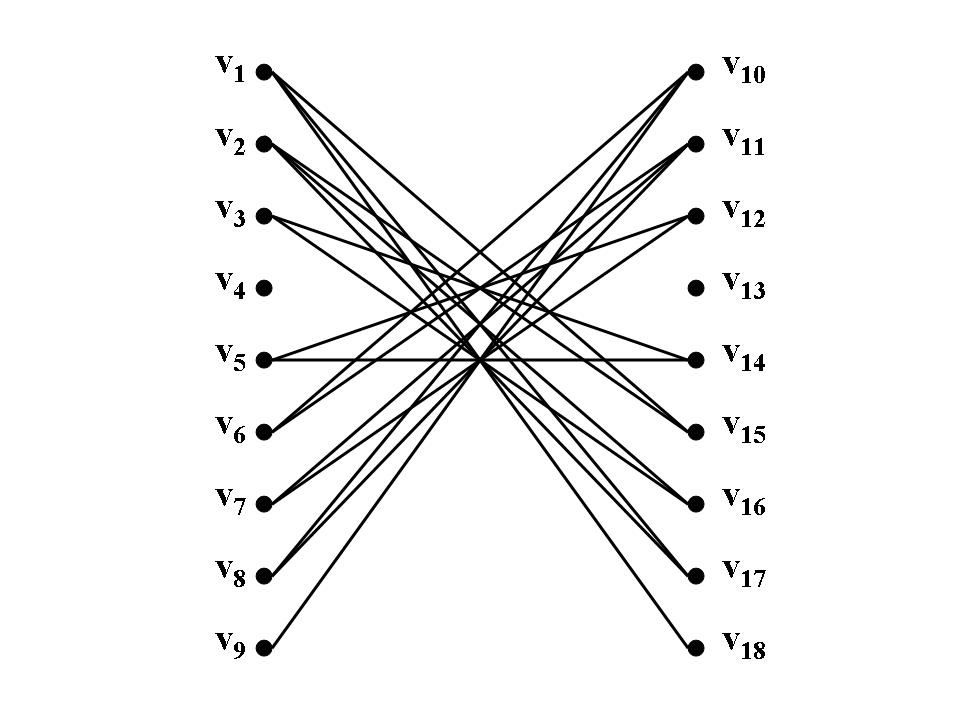This is actually one of my project when I was in college during my “Mathematical Programming” class. I used R programming language to solve missionaries and cannibals problem with matrix analysis and graph theory.
Introduction
The missionaries and cannibals problem, and the closely related jealous husbands problem, are classic river-crossing logic puzzles. In the missionaries and cannibals problem, three missionaries and three cannibals must cross a river using a boat which can carry at most two people, under the constraint that, for both banks, if there are missionaries present on the bank, they cannot be outnumbered by cannibals (if they were, the cannibals would eat the missionaries). The boat cannot cross the river by itself with no people on board.

Solving
A system for solving the Missionaries and Cannibals problem whereby the current state is represented by a simple vector
There are only 18 states left, and we use
We know that everyone departs from east side, that is, the initial vertex is
Obviously, the procedure is reversible:
This means the two vertexs has symmetric relation, we then use undirected arrow to connect them. For example, let’s say we make missionaries and cannibals start from
By repeating the above algorithm, we can get an undirected graph.

In order to compute this in matrix, I define a
where
From above, we can tell that journey starts from
If we do not pass through the vertex of repeat visits, which means that
The power of the adjacency matrix
This property provides an easy method to find the shortest path: calculated continuously
Computation in R
I define a variable B representing the adjacency matrix mentioned above and build a function to compute the power to a matrix.
B <- matrix(c(
0, 0, 0, 0, 0, 1, 0, 1, 1,
0, 0, 0, 0, 0, 1, 1, 1, 0,
0, 0, 0, 0, 1, 0, 1, 0, 0,
0, 0, 0, 0, 0, 0, 0, 0, 0,
0, 0, 1, 0, 1, 0, 0, 0, 0,
1, 1, 0, 0, 0, 0, 0, 0, 0,
0, 1, 1, 0, 0, 0, 0, 0, 0,
1, 1, 0, 0, 0, 0, 0, 0, 0,
1, 0, 0, 0, 0, 0, 0, 0, 0), nrow=9)
power = function(x, n) Reduce(`%*%`, replicate(n, x, simplify=FALSE))For
power(B, 3)
[,1] [,2] [,3] [,4] [,5] [,6] [,7] [,8] [,9]
[1,] 0 0 0 0 0 5 2 5 3
[2,] 0 0 0 0 1 5 4 5 2
[3,] 0 0 1 0 3 1 3 1 0
[4,] 0 0 0 0 0 0 0 0 0
[5,] 0 1 3 0 3 0 1 0 0
[6,] 5 5 1 0 0 0 0 0 0
[7,] 2 4 3 0 1 0 0 0 0
[8,] 5 5 1 0 0 0 0 0 0
[9,] 3 2 0 0 0 0 0 0 0Vertex first visited:
Shortest path length:
Total number of path: 2
For
power(B, 5)
[,1] [,2] [,3] [,4] [,5] [,6] [,7] [,8] [,9]
[1,] 0 0 0 0 2 25 14 25 13
[2,] 0 0 1 0 6 26 19 26 12
[3,] 0 1 5 0 10 7 11 7 2
[4,] 0 0 0 0 0 0 0 0 0
[5,] 2 6 10 0 10 1 5 1 0
[6,] 25 26 7 0 1 0 0 0 0
[7,] 14 19 11 0 5 0 1 0 0
[8,] 25 26 7 0 1 0 0 0 0
[9,] 13 12 2 0 0 0 0 0 0Vertex first visited:
Shortest path length:
Total number of path: 2
For
power(B, 7)
[,1] [,2] [,3] [,4] [,5] [,6] [,7] [,8] [,9]
[1,] 0 0 2 0 18 127 80 127 63
[2,] 0 1 8 0 32 135 96 135 64
[3,] 2 8 21 0 36 41 46 41 16
[4,] 0 0 0 0 0 0 0 0 0
[5,] 18 32 36 0 35 9 22 9 2
[6,] 127 135 41 0 9 0 1 0 0
[7,] 80 96 46 0 22 1 7 1 0
[8,] 127 135 41 0 9 0 1 0 0
[9,] 63 64 16 0 2 0 0 0 0Vertex first visited:
Shortest path length:
Total number of path: 2
For
power(B, 9)
[,1] [,2] [,3] [,4] [,5] [,6] [,7] [,8] [,9]
[1,] 0 2 22 0 118 651 432 651 317
[2,] 2 11 49 0 168 700 494 700 334
[3,] 22 49 86 0 139 226 210 226 98
[4,] 0 0 0 0 0 0 0 0 0
[5,] 118 168 139 0 128 60 97 60 20
[6,] 651 700 226 0 60 1 11 1 0
[7,] 432 494 210 0 97 11 38 11 2
[8,] 651 700 226 0 60 1 11 1 0
[9,] 317 334 98 0 20 0 2 0 0Vertex first visited:
Shortest path length:
Total number of path: 2
For
power(B, 11)
[,1] [,2] [,3] [,4] [,5] [,6] [,7] [,8] [,9]
[1,] 4 28 164 0 690 3353 2284 3353 1619
[2,] 28 86 277 0 879 3628 2556 3628 1734
[3,] 164 277 360 0 574 1212 1011 1212 550
[4,] 0 0 0 0 0 0 0 0 0
[5,] 690 879 574 0 492 357 442 357 140
[6,] 3353 3628 1212 0 357 15 84 15 2
[7,] 2284 2556 1011 0 442 84 195 84 24
[8,] 3353 3628 1212 0 357 15 84 15 2
[9,] 1619 1734 550 0 140 2 24 2 0Vertex first visited:
Shortest path length:
Total number of path: 4
Therefore all the missionaries and cannibals have crossed the river safely.
Conclusion
As a math major student, it may very well be true that we won’t use some of the more abstract mathematical concepts we learn in school unless we choose to work in specific project. We are taught lots of useless things in math major. However, the underlying skills we developed in mathametics class, such as thinking logically and solving problems, will last a lifetime and help us solve work-related and real-world problems.

